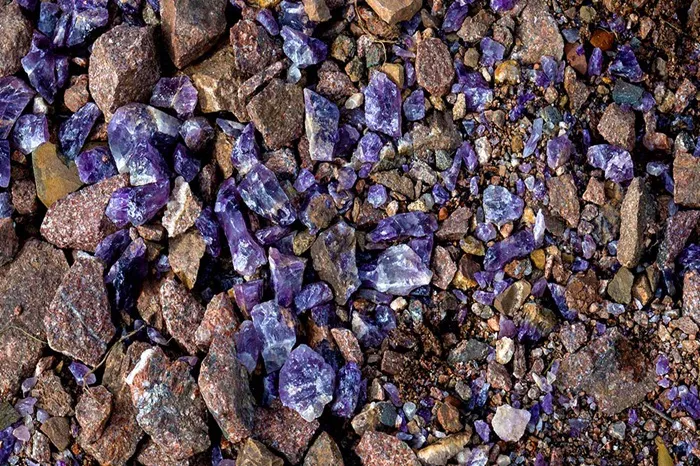Amethyst, a variety of quartz prized for its stunning purple hues, is found in abundance across the globe. This gemstone occurs in a variety of locations, from Brazil’s vast deposits to the smaller, specialized mines in Siberia. Below is a detailed exploration of where amethysts are mined, organized geographically to highlight key regions and their unique contributions to the gemstone’s diversity.
Global Overview
Amethysts are mined on every continent except Antarctica, reflecting their widespread availability. However, not all amethysts are equal—some regions produce stones renowned for their intense coloration, clarity, or historical significance.
Brazil
Mining Areas: Minas Gerais, Rio Grande do Sul, and Bahia.
Characteristics: Brazilian amethyst is among the most abundant and varies from light lavender to deep purple. Some stones feature color zoning.
Significance: Brazil has dominated the global amethyst market for decades, supplying high-quality stones in large quantities.
Uruguay
Mining Areas: Artigas region.
Characteristics: Renowned for its deep violet amethysts, often with flashes of blue or red.
Significance: Uruguayan amethyst is highly prized for its vivid saturation and exceptional quality.
United States
Mining Areas: Four Peaks (Arizona), Jackson’s Crossroads (Georgia).
Characteristics: Arizona’s amethysts exhibit rich purples with red flashes, while Georgia produces lighter, pastel stones.
Significance: Four Peaks amethysts are particularly valued for their rarity and vibrant colors.
Canada
Mining Areas: Thunder Bay, Ontario.
Characteristics: Known for its reddish-purple hues and hematite inclusions, creating a unique sparkle.
Significance: Thunder Bay amethysts are distinct for their earthy undertones and local significance.
Russia
Mining Areas: Ural Mountains (historical), Siberia.
Characteristics: Siberian amethyst is legendary for its deep, rich purple color with flashes of red and blue.
Significance: Historically, Siberian amethysts were considered the finest in the world and were favored by royalty.
Finland
Mining Areas: Luosto region.
Characteristics: Finnish amethyst often has a softer, pastel tone.
Significance: Amethyst mining here is small-scale and supports sustainable tourism.
Zambia
Mining Areas: Kariba region.
Characteristics: Known for high-quality stones with deep purple hues and excellent clarity.
Significance: Zambian amethysts are becoming increasingly popular on the international market for their richness and affordability.
Madagascar
Mining Areas: Ambatondrazaka region.
Characteristics: Produces a range of hues, from soft lavender to vibrant purple.
Significance: Madagascar is an emerging source of beautifully colored amethysts.
India
Mining Areas: Jaipur (cutting and polishing hub).
Characteristics: While not a major producer, India is known for processing amethysts sourced from other regions.
Sri Lanka
Characteristics: Rare and unique purple stones occasionally mined alongside sapphires.
Australia
Mining Areas: Queensland, New South Wales.
Characteristics: Australian amethysts tend to have lighter hues with occasional color zoning.
Significance: While less famous globally, these stones cater to local markets.
Maps and Visual Aids
A world map showcasing major amethyst mining locations can provide a clearer understanding of global distribution. Highlight regions like Brazil, Uruguay, Siberia, Zambia, and Thunder Bay for their notable contributions to the gemstone market.
How Origin Affects Value
The origin of amethyst can influence its perceived quality. For example:
Siberian amethysts are highly valued for their rich hues.
Uruguayan stones often fetch premium prices for their intense color.
Thunder Bay amethysts are unique due to their reddish inclusions, appealing to collectors.
Responsible Sourcing
As interest in ethical gemstones grows, some amethyst mines focus on sustainable practices. For instance, Finland’s Luosto mine promotes eco-friendly mining and tourism, while Zambia emphasizes fair-trade standards. Buyers should look for certifications that ensure responsible sourcing when possible.
Conclusion
Amethyst’s beauty transcends borders, with significant deposits found worldwide. From the deep purples of Siberia and Uruguay to the hematite-speckled stones of Thunder Bay, each region offers something unique. Whether you’re drawn to amethyst for its color, clarity, or origin, understanding its global sources adds depth to its allure. Explore responsibly sourced options to appreciate this gemstone’s splendor while supporting ethical practices.
Related topics:


